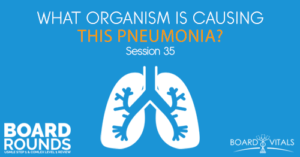
Infectious Disease! A young man presents with increasing SOB and green sputum. Sputum culture shows α-hemolytic gram-positive cocci in chains. Name that bug! We’re joined by Dr. Mike Natter from BoardVitals. Find him on Instagram @mike.natter.
If you’re looking for some more help with your Step 1 or Level 1 prep, go to BoardVitals to see their amazing QBank. Have a glimpse of all questions you need to prepare for your boards. They include over 1,700 questions along with explanations and resources to help you understand better. Use the promo code BOARDROUNDS and get 15% off.
Listen to this podcast episode with the player above, or keep reading for the highlights and takeaway points.
A 35-year-old man presents to his primary care physician a three-day history of increasing shortness of breath and a productive cough with green sputum. He has no significant past medical history.
Physical exam reveals decreased breath sounds and dullness to percussion in the right lower lung field. A sputum sample is obtained and sent for gram staining. It demonstrates large numbers of gram-positive cocci in chains.
When these cells are cultured on a blood agar plate, an alpha-hemolytic reaction is observed. Based on these microbiology results, which of the following is the most likely diagnosis:
(A) Haemophilus influenza pneumonia
(B) Klebsiella pneumonia
(C) Staphylococcus aureus pneumonia
(D) Streptococcus agalactiae pneumonia
(E) Streptococcus pneumoniae
[Related episode: Which of These Bacteria Are Causing Pneumonia?]
A 35-year-old guy with no medical history then has picked this in the community. He’s immunocompromised, not a child, and all these other things. It means he’s going to likely pick up the most common form of pneumonia in the community which is Streptococcus pneumoniae.
From a micro standpoint, there are two things to think about Streptococcus pneumoniae. They’re gram-positive cocci in chains. And on the blood agar, it’s going to be alpha-hemolytic. Look for ways to tap this into your memory. Draw a picture or create an affiliation. Think of s story.
'However you want to find a way to tap that into your memory – draw a picture, create an affiliation, think of a story – those things are definitely worth memorizing for test purposes.'Click To TweetWith Haemophilus influenza pneumonia, think of a young kid with inner ear infections. These are typically going to be seen in young kids or immunocompromised patients.
Klebsiella pneumonia is seen on immunocompromised folks. It’s characterized by currant jelly sputum.
Staphylococcus aureus pneumonia is really bad. This is not someone who’s just going to be strolling around. You can get real sick with this. It’s gram-positive. It’s a bacillus, not a cocci. This is going to help you differentiate this from Strep.
Streptococcus agalactiae is what neonates get as they pass through the birth canal. It’s a pathogen causing meningitis. You can get pneumonia, but very rare. It’s also betahemolytic so it might be difficult to differentiate just based on that. It’s known as the Group B strep that women are tested for before they give birth.
Streptococcus pneumoniae is the most common type of pneumonia which you will see in the community almost all the time. It’s very much affiliated with the alpha-hemolytic reaction as well as the gram-positive cocci in pairs.
It can be very easily treated with a penicillin G or amoxicillin. If you’re allergic to penicillin, you can do a third-generation cephalosporin. Or if you really need penicillin, you can desensitize someone. But for strep pneumonia, there are other options.
BoardVitals (Use the promo code BOARDROUNDS and get 15% off.)
Follow Dr. Mike Natter on Instagram @mike.natter.

Lorem ipsum dolor sit amet, consectetur adipiscing elit
I just received my admission to XXXXX! This is unreal and almost feels like I am dreaming. I want to thank you for all of your help with my application. I cannot overstate how influential your guidance and insight have been with this result and I am eternally grateful for your support!
IM SO HAPPY!!!! THANK YOU SO MUCH FOR ALL YOUR HELP, IM INDEBTED TO YOU! Truly, thank you so much for all your help. Thank you doesnt do enough.
I want to take a few moments and thank you for all of your very instructive, kind and consistent feedback and support through my applications and it is your wishes, feedback, and most importantly your blessings that have landed me the acceptance!
I got into XXXXX this morning!!!! It still has not hit me that I will be a doctor now!! Thank you for all your help, your words and motivation have brought me to this point.
I wanted to once again express my heartfelt gratitude for your help in providing feedback during my secondary applications. Your guidance has been instrumental in my journey.
Just wanted to share my wonderful news! I received my first medical school acceptance! Thank you for all that you do for us Application Academy!!!
I am excited to tell you that I just got my third interview invite from XXXXX today! I can’t believe it. I didn’t even know if I was good enough to get one, let alone three – by mid-September. Thank you so much for all of your help and support up to this point; I would not be in this position without it!!
I wanted to thank you for helping me prepare for my XXXXX interview. Even in a 30-minute advising session, I learned so much from you. Thank you for believing in me, and here’s to another potential success story from one of your advisees!
I just received an acceptance with XXXXX! This is so exciting and such a huge relief and so nice to have one of our top choice schools! I also received an interview with XXXXX which brings the total up to 20 interviews! Thank so much, none of this would have been possible without you!